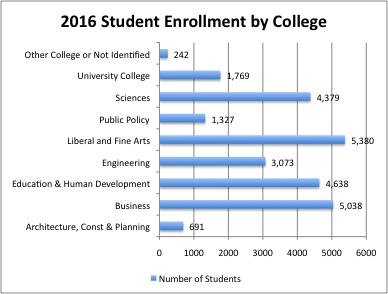One-fourth of all annual UTSA undergraduate degree recipients are COLFA majors.
More students are enrolled in the College of Liberal and Fine Arts (COLFA) than any other college on campus, according to the Spring 2016 semester preliminary census report conducted by the UTSA Office of Institutional Research. The report indicates that 5,380 students—20 percent of the student population— are enrolled in COLFA.
With 11 departments in fine arts, humanities and social sciences, COLFA is one of the most academically diverse colleges. Annually, COLFA hosts over 100 lectures, exhibitions and concerts that are open to the public, catering to more than 70,000 guests each year. The college is a substantial patron of the arts and humanities in South Texas.
The college offers 29 undergraduate degree programs and 28 minors. Because of the college’s diverse fields of study and coursework, 33 percent of all credit hours taken are courses in fine arts and in liberal arts.
COLFA Dean Daniel Gelo asserts that COLFA provides more credit hours than any other college. Many non-liberal arts majors benefit from the college’s programs, as well with virtually all UTSA graduates taking at least one liberal and fine arts course during their academic career.
COLFA’s vision is to provide core intellectual experience in order to prepare their students for the roles as responsible citizens in a free society.
“Many students just find liberal and fine arts exciting,” Gelo said. “Students tend to achieve more when they are truly interested in what they are studying.”
Nyssa Henneberg, a senior English major, feels that her major helps with her write and communicate more effectively. When it comes to the inevitable naysayers who say she cannot find a job with a BA in English, Henneberg simply replies that she wants happiness and not money.
Henneberg stated that she loves literature because it connects so many different types of people and allows a reader to experience places and things he or she would not otherwise experience.
According to Forbes, the highest starting salary for liberal arts majors is $43,100— compared to a engineering, computer science and finance majors who can earn starting salaries between $56,100 and $70,400.
While Gelo acknowledges that liberal arts majors starting salary are typically lower than those of mechanical and business majors, he believes liberal arts majors tend to catch up in earnings over their entire careers and are more likely to assume leadership positions.
David Rodriguez, a junior communication major, believes that his major will give him real world experience in the communications field. He claims that so far that his major has helped him with his public communication skills, professional and technical writing skills and more effective communication skills.
“Communication skills, creativity, adaptability and familiarity with people and places through history and around the world are all qualities that the liberal and fine arts emphasize and develop,” Gelo said. “That’s what employers are looking for.”







